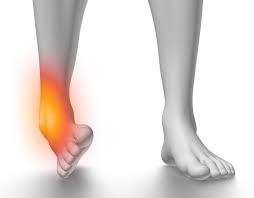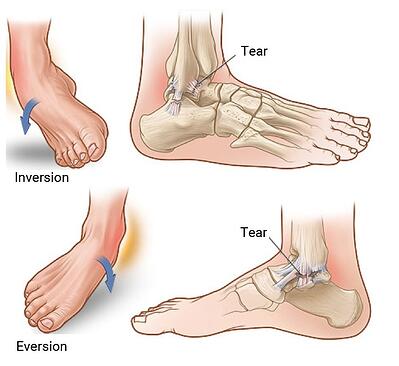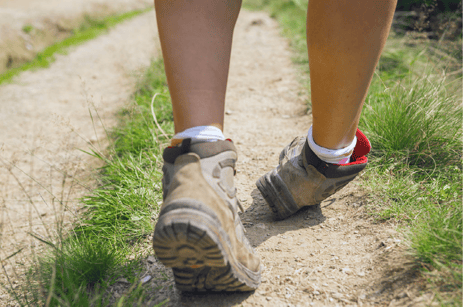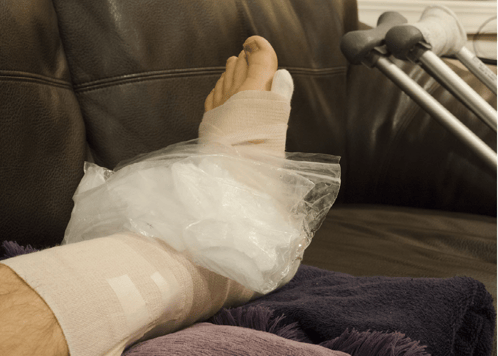What is an Ankle Sprain? How Do You Treat it?

What is an Ankle Sprain? How Do You Treat it?
Ankle sprains are an extremely common injury, especially for athletes. Sports such as soccer, basketball, and volleyball involve a lot of running, jumping, and lateral movements, making it all the more easy to sprain your ankle. Ankle sprains, however, are not privy to just athletes; anyone could sprain their ankle.

Types of Ankle Sprains
Inversion
Inversion ankle sprains occur when you twist your foot upward and the ankle rolls inward, tearing the ligaments on the lateral side of the ankle. Inversions ankle sprains are the most common, occurring in about 85% of all ankle sprains.
Eversion
Eversion ankle sprains occur when the ankle rolls outward and tears the deltoid ligaments (the ligaments on the medial side of your ankle).

Causes
An ankle sprain happens when either the medial or lateral ligaments of the ankle are stretched or torn. Ankle sprains, or sprains in general, can range from mild to severe. A mild ankle sprain stretches the ligaments, but does not loosen the joint. A moderate ankle sprain is classified as a partial tear to the ligaments and creates an unstable joint. Finally, a severe ankle sprain involves completely tearing the ligaments and creates a nonfunctional joint.
Ankle sprains can occur for many reasons, the most common include:
- High impact sports. Sports involving running, jumping, climbing, or kicking can increase the risk for ankle sprains. Additionally, another player could step on your foot, causing your foot your roll inward.
- Wearing improper footwear (for your sport or activities of daily life).
- Putting unusual stress or force on the ligament. Walking or running on uneven surfaces or twisting your ankle can cause ankle sprains.
- Your foot could land awkwardly when running, stepping down, or even getting out of bed.

Symptoms
Symptoms you may experience following an ankle sprain include:
- Swelling.
- Pain, especially when weight bearing.
- Inability to bear weight on ankle.
- Tenderness.
- Redness, warmth, possible bruising.
- Ankle stiffness and/or limited range of motion.
- Instability, limping.
- Depending on severity of sprain, you might hear and feel a popping sensation or sound at the time of injury.
Treatment
Early treatment for ankle sprains is aimed at reducing inflammation, which helps to relieve pain and speed up the healing process. Here at Human Integrated Performance, we recommend the RICE method.
Rest
Take weight off your ankle! You may need to take a break from, or modify, your daily activities to give your ankle sprain time to heal. Use crutches to help take weight off your ankle and help you get around.
Ice
Applying a bag of ice, or frozen veggies, will help to reduce swelling and pain. This should be done for 10-20 minutes, three times a day (more if needed). We recommend that you place a towel, or piece of fabric, around the bag of ice or an ice pack.
Compression
Use elastic wrap, such as Ace bandages, to compress your ankle. This will provide support and prevent inflammation. Try to not wrap it too tight as this can cause more swelling. Signs that your bandage is too tight include: numbness, tingling, increased pain, coolness, or increased swelling.
Elevation
Elevate your ankle using a few pillows anytime you are sitting or lying down. To help minimize swelling, elevate your ankle high enough so that it is at or above the level of your heart.

After you have taken time to rest, consult your doctor, you may benefit from physiotherapy to rebuild strength and improve function. If you wish to book with one of our physiotherapists, email us at info@yeghip.com or call us at 780-862-3111.
FAQ's
1. Can I walk on a sprained ankle?
Walking on a sprained ankle is not advised. Your ankle needs time to heal; weight bearing too soon can cause further damage and take longer to heal.
2. How can I prevent a sprained ankle?
There are many things that you can do to prevent an ankle sprain. Some of which include: wearing the appropriate footwear for an activity; walking, running, or playing on even surfaces; taping a weak ankle prior to participating in sports; and strengthening your ankle joint.